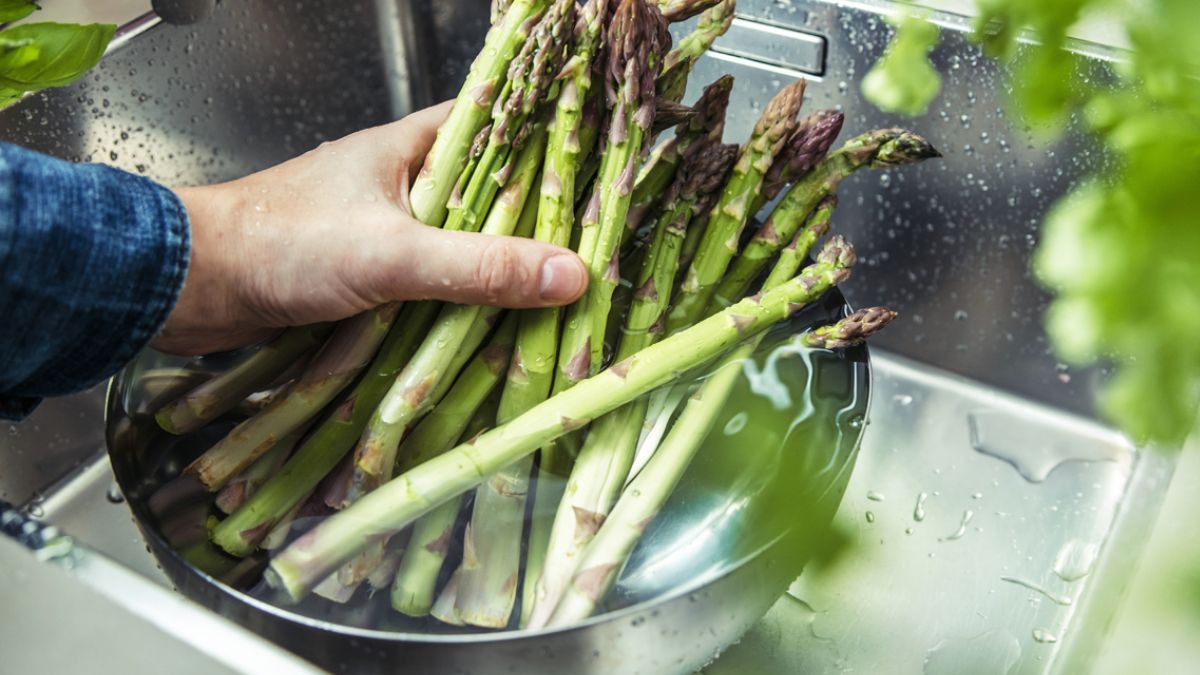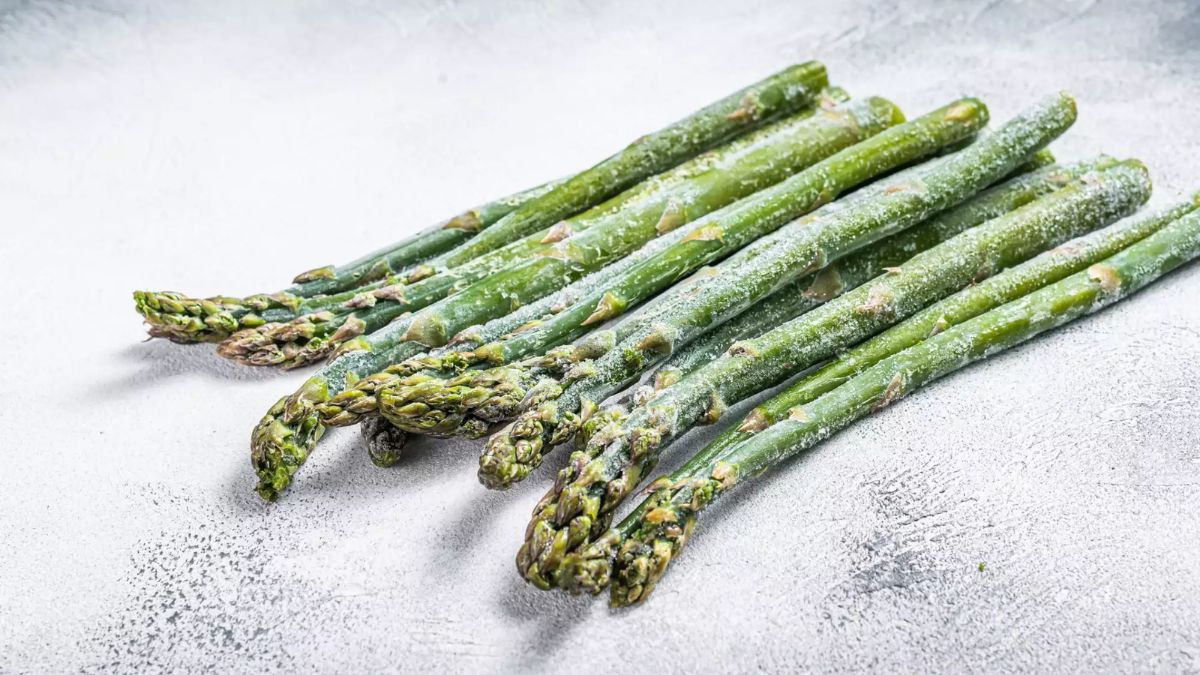Asparagus is a popular vegetable on our tables, but is it a vegetable or a fruit? Many people don’t care if it’s a fruit or a vegetable because it’s a portion of healthy food. While the body is unconcerned, we must correct the situation. Asparagus is a vegetable that has been grown for hundreds of years. The name “asparagus” is derived from the Greek words “aspa” and “ragoûs,” which indicate spear and food, respectively.
It’s available at practically every supermarket. Asparagus belongs to the Liliaceae family of vegetables, and this family is distinguished by its six-petaled flowers and tall vertical leaves (similar to lilies). Garlic, onions, chives, and leeks are all members of this vegetable family. The plant is also recognized for its distinct sulphurous odour (this is why Asparagus causes your pee to smell like rotten eggs).
How to Freeze Asparagus?
To freeze blanched, chilled, and drained asparagus spears or pieces, place them in freezer bags or containers, label the date, and freeze. Flash freeze the asparagus spears or pieces if you want them to stay loose and not cling together (so you may pull out only what you need).
The easiest way to store leftover asparagus season vegetables for more than a week is to freeze them. To freeze Asparagus, follow this step-by-step guide:
Blanch: Blanch the Asparagus before freezing it to keep its colour and texture. Cook the asparagus spears for two to five minutes in boiling water, then immediately move them to a bowl of ice water to stop the cooking process.
Flash freeze: You must flash freeze your Asparagus to keep it from sticking together in the freezer bag. Arrange the asparagus stalks on a baking tray lined with paper towels, leaving an inch or two between each stalk. Freeze the pan for one to two hours or until the spears are completely frozen.
Store: Transfer your asparagus spears to an airtight container or freezer bag labelled with the date after freezing. Frozen Asparagus will last for eight to twelve months in the freezer.
Is Asparagus a Vegetable?
Asparagus is a nutrient-dense perennial vegetable that grows worldwide in temperate regions. “Spikes” are the two or three stalks produced by the plant per stalk node. Each spike can have up to 20 spearlets, each of which can reach a length of one foot. Since ancient times, Asparagus has been revered for its health advantages, and it should be a staple in everyone’s diet.
A modest plot of Asparagus should be in every garden! Because of the part of the plant eaten, namely the young stem, Asparagus is categorized as a vegetable. These immature stems can be eaten raw, cooked, or pickled and are considered vegetables.
Asparagus is a stem vegetable, not a leafy green. Planting shoots in the ground allows the plant to grow. Before producing seeds or blooms, these shoots, sometimes called spears, are picked for nourishment. Purple asparagus shoots with burgeoning tips are most likely blossoming.
The young stem of Asparagus is edible, so it is classified as a vegetable in the culinary world. These delicate uncooked stems are used in salads and dips because of their crisp texture. The root end is frequently cut off because it includes rough fibres and isn’t particularly tasty.
Varieties of Asparagus
A) Green Asparagus
This is the most common type of Asparagus, and it’s available at practically every grocery shop in the United States. Green Asparagus comes in various varieties, including the Jersey King (the most popular), Jersey Knight, Jersey Giant, Mary Washington, and PrecoceD’Argenteuil.
B) White Asparagus
This is a more uncommon variety of Asparagus. White Asparagus contains no colour, which explains why it is lighter in colour and has a milder flavour than green or purple. It is created by depriving the plant shoot of light, which is required to produce chlorophyll. In Europe, white Asparagus is the most popular.
C) Purple Asparagus
This kind, popular in England and Italy, is the sweetest and most sensitive of the three. The purple colour comes from anthocyanins, red wine and dark chocolate. Purple Asparagus is typically cooked or eaten raw, though the purple colour will fade if cooked over an extended time.
How to Store Fresh Asparagus?
Most home cooks keep Asparagus in the crisper drawer of their refrigerator in a plastic produce bag from the grocery store. Keeping your Asparagus in a container, on the other hand, will help it last longer. To keep your Asparagus fresh in the fridge, follow these steps:
Trim: Before storing your Asparagus, give it a thorough rinse in cold water. Using a paper towel or a dishcloth, dry them completely. Remove one inch of the asparagus stalks’ bottoms or woody ends.
Prepare the container: 1 inch of water in a Mason jar or similarly shaped container Place your Asparagus in the jar with the cut ends of the stalks at the bottom, similar to how you would store cut flowers. The stalks should then be covered with a plastic bag and sealed with a rubber band around the jar.
Refrigerate: Keep an eye on your Asparagus from time to time. It should be used within a week or until the cut sides of the asparagus stalks become mushy.
Where did Asparagus Come from?
Asparagus is thought to have originated in the eastern Mediterranean and expanded over Europe afterward. In those locations and in America, where it was first imported in the 1800s, the plant now thrives freely.
Before it arrived in the kitchen, Asparagus was used to treat disorders such as heart disease, bee stings, and even toothaches. The Greeks are known to have eaten the plant in its natural state, whereas the Romans domesticated it later. They could also dry the spears and utilize them for various purposes afterward.
The texture of Asparagus
Asparagus has a rough, crunchy, and very fibrous texture when raw. The bottom few inches of the vegetable are so tough that they are virtually inedible, causing many to clip them off before cooking. Cooked Asparagus can keep crisp (which takes less cooking) or become mushy (which requires more cooking) (this happens when overcooked). Both methods are wonderful and tasty; the choice is entirely up to you.
How to Eat Asparagus Correctly?
Asparagus is a crisp, sturdy vegetable. It’s best to eat Asparagus with a knife and fork, especially if it’s part of the main course. Using a knife and fork is also part of proper eating etiquette, so this simple change in technique can solve two problems at once. If required, you can bend the Asparagus by hand, but don’t do it too often or too long. Serve with a dip or sauce that complements the unique flavour.
Asparagus that hasn’t been cooked isn’t as good, and this is because all of the dips and sauces give a lot of flavour and excitement to the dish. Protein can be obtained by serving Asparagus with meat, fish, or vegetables. If there is no protein in the dish, you will feel hungry immediately after finishing it, as is always the case when eating vegetables on their own.
Asparagus Uses
Asparagus is a multipurpose vegetable that should be eaten prepared rather than raw. It is not inedible raw, but the flavour is weak, and it is quite difficult on the digestive tract. Thus it is best utilized cooked. Asparagus can be baked, steamed, pan-fried, or grilled, and it goes great with your preferred seasoning or a squeeze of lemon juice. It also works well as a side vegetable. Asparagus is also delicious in soups (hello, asparagus cream soup! ), pasta, potato dishes, and stir-fries.
Is Asparagus a Healthy Vegetable?
Asparagus is a vegetable that is high in nutrients. Fibre, folate, vitamins A, C, E, and K, and chromium, a trace mineral that helps insulin transport glucose from the bloodstream into cells, are abundant.
It can Help Fight Cancer-
This herbaceous plant, like avocado, kale, and Brussels sprouts, is high in glutathione, a detoxifying chemical that aids in the breakdown of carcinogens and other toxic substances such as free radicals. As a result, asparagus consumption may aid in preventing and treating malignancies of the bone, breast, colon, throat, and lungs.
Asparagus is Packed with Antioxidants-
It’s one of the best fruits and vegetables for fighting free radicals that cause cell damage. This may aid in the slowing of the aging process and the reduction of inflammation.
Asparagus is a Brain Booster-
Another anti-aging benefit of this tasty spring vegetable is that it may aid with cognitive decline. Asparagus, like leafy greens, contains folate, which, when combined with vitamin B12 (found in fish, chicken, pork, and dairy), helps prevent cognitive impairment. According to a Tufts University study, older persons with adequate folate and B12 fared better on response speed and mental flexibility tests. (If you’re over 50, be sure you’re getting enough B12 because your ability to absorb it diminishes as you get older.)
Do I Need to Peel Asparagus?
Any asparagus with a woody bottom inch or two should be eliminated. The thickness of the stalks will determine whether or not you peel them. The tougher the asparagus peel is, the more likely it will need to be peeled. If the Asparagus is 1/2-inch in diameter or greater, I usually peel the stems. Any recipe that advises you to peel Asparagus before cooking should be avoided. It’s not just time-consuming, but it’s also unnecessary. According to Rick Martinez, BA’s digital associate food editor, as long as the bottom section of the stalk is removed, the rest is completely edible.
Asparagus Nutrition Value
While Asparagus is high in certain nutrients, it is also low in calories, appealing to many individuals. Asparagus offers only 34 calories per 100-gramme meal while also providing a good quantity of vitamin K, iron, and protein. Asparagus contains 56 micrograms of vitamin K or 62 percent of the recommended value. There are also 2.9 milligrammes of iron (16 percent of a daily intake) and 2.9 grammes of protein (6 percent of a daily serving). Folate, 202 milligrammes of potassium, and a high level of flavonoids like Isorhamnetin and Quercetin are also important elements in Asparagus.
Conclusion
You now know the answer to whether Asparagus is a vegetable. Asparagus is a vegetable as well as a member of the stem family. It’s a good source of vitamins A, C, and E, and it’s also strong in fibre. The young stem or shoot of Asparagus is the part that is eaten. We can consume these shoots without danger of poisoning because they are taken before they begin to blossom. Even though these stems are harsh when raw, boiling them improves their flavour. Because of its peculiar flavour, which develops after cooking, some consider it an acquired taste. The stems of mature plants are stiff and flavourless, and they’re not palatable and should be left out of those dips and salads.


